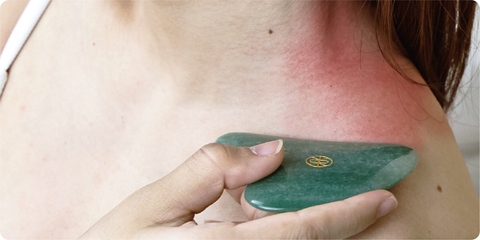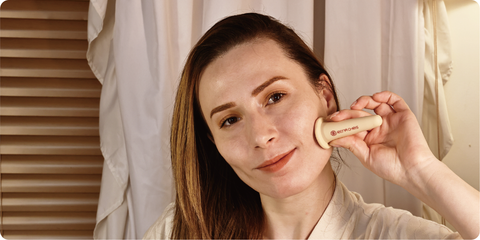Gua Sha vs. Cupping: Exploring the Contrasts and Benefits
Gua sha and cupping have become increasingly popular in recent years as more people discover these traditional Chinese medicine therapies. Both practices involve creating temporary marks on the skin through scraping or suction to provide a range of health and wellness benefits.

However, gua sha and cupping use different techniques and have key differences in their effects and uses. This comprehensive guide will explain exactly what gua sha and cupping are, how they work, their benefits, safety precautions, and more. Read on to learn when and how to use gua sha versus cupping, depending on your health goals.
What Is Gua Sha?

Gua sha (pronounced "gwah-shah") is an ancient Chinese healing technique that scrapes the skin with a smooth, round-edged tool to improve circulation and promote healing. It dates back at least 2,000 years and is used to treat various conditions.
In gua sha, a licensed practitioner presses and scrapes a tool across your skin in short strokes or "pull." This creates light red petechiae called "sha" as blood and toxins are brought to the surface. The sha fade within a few days after treatment.
Gua sha tools are commonly made from jade, rose quartz, or other smooth materials. The practitioner applies oil to the skin first to allow smooth gliding motions. Gentle downward scraping motions are done on the face, while pull strokes go towards the heart on the body.
What Is Cupping Therapy?

Cupping therapy has been practiced for thousands of years across Asia, the Middle East, and Europe. It involves placing heated glass cups on the skin and creating suction to draw the skin and underlying tissues into the cup.
This suction breaks capillaries and causes circular, deep red marks as blood flow increases to the area. Cups may be placed statically or moved around for massage cupping. Sessions last 5-20 minutes.
Cupping may be done using dry, wet, or fire cups, depending on the method used to create suction. It should only be performed by licensed acupuncturists or other certified practitioners.
Key Differences Between Gua Sha and Cupping
Though gua sha and cupping are both forms of traditional Chinese medicine, they have some distinct differences:
- Technique: Using a smooth-edged tool, Gua sha involves repetitive scraping motions across the skin's surface. The practitioner applies oil and glides or pulls the tool over the skin, usually in downward strokes towards the heart. Cupping uses suction through static placements of round cups on the skin. A pump or heat is used to remove air from the cups to pull the skin up into the cup.
- Depth: Gua sha focuses on superficial layers like the muscle, fascia, and subcutaneous tissues. It brings blood flow to these upper levels. Cupping impacts deeper tissues below the skin and fascia, drawing blood and lymph fluid up from below the surface.
- Skin response: Gua sha intentionally causes light petechiae and small red or purple spots from broken capillaries. This indicates increased surface circulation. Cupping causes circular bruising or hickeys on the skin from the strong suction forcibly pulling blood up via the capillaries.
- Application: Using adequate pressure, Gua sha requires gliding, pulling, and unidirectional strokes across the lubricated skin. Cups are placed statically on the skin after gua sha to create strong suction and compression on tissue in a fixed location.
- Ailments treated: Gua sha is commonly used to treat upper respiratory conditions, muscle aches, stiffness, inflammatory conditions, and pain issues. Cupping is frequently used for gut and digestion problems, lung congestion, anxiety, cellulite, and stubborn muscle adhesions.
- Combined use: Practitioners may strategically combine gua sha and cupping in one treatment to enhance outcomes. The gua sha first brings blood to the surface, allowing the cupping to draw deeper into stiff, tight tissues that need therapeutic circulation.
The Benefits of Gua Sha and Cupping
Though gua sha and cupping use different techniques, they provide overlapping healing benefits, including:
- Pain reduction - Both techniques can decrease muscle knot discomfort, injuries, and chronic pain from fibromyalgia. The increased circulation aids healing.
- Improved circulation and lymph drainage - Scraping and suctioning boost blood and lymph fluid movement to stagnant areas that need nutrient delivery and waste removal.
- Reduced inflammation - Increasing fresh oxygenated blood flow decreases localized swelling, inflammation, and redness.
- Range of motion improvement - Relieving muscle and fascia tightness allows for greater mobility and flexibility.
- Stress and anxiety relief - The rhythmic motions and full-body effects can induce relaxation. Calming neurotransmitters are released.
- Clearing of "blood stagnation" - Stagnant, oxygen-poor blood trapped in tissues is released to improve flow and energy.
- Immune system boosting - Increased white blood cell circulation fights viruses and prevents illness. Toxins and waste buildup are cleared.
Gua sha also uniquely provides:
- Enhanced immunity - Scraping boosts lymphatic drainage, which supports immune function.
- Fever and chill alleviation raises Yang qi to help resolve fever or chills.
- Cough, cold, and respiratory illness relief clears lung congestion, bronchial inflammation, and phlegm.
- Smoother, brighter facial complexion - It enhances collagen, blood flow, and lymph drainage in the face.
- Cellulite improvement and myofascial release - It smooths connective tissue and breaks down adhesions.
Cupping uniquely offers:
- Back, neck, and shoulder pain relief - Strong suction targets chronic tension areas.
- Improved digestion and gut health - It releases gut obstructions, bloating, and congestion.
- Cough and asthma treatment - Lung congestion is cleared through upper back cupping.
- Cellulite reduction - Suction and massage smooth and loosen fat and connective tissue.
- Mental wellness and relaxation - Calming, meditative states are induced by broad effects.
Conclusion
In summary, gua sha and cupping utilize different techniques but share common goals of dispersing stagnant blood and energy, reducing inflammation, and promoting healing. Cupping brings blood to the surface through suction, while gua sha does so through mild scraping. Understanding the differences allows practitioners to select the most appropriate therapy for patients' health complaints. Or both modalities may be combined for a synergistic effect. When applied skillfully by certified professionals, gua sha and cupping can safely enhance wellness and treat various conditions.

1 comment
Were you serious in telling us that we could use the cupping method to deal with mental distress too? Well, well… looks like my sister should check out this option by contacting a holistic healer shortly. She’s been feeling a bit stressed out since last week due to her office work. https://acupuncturesedona.com/cupping